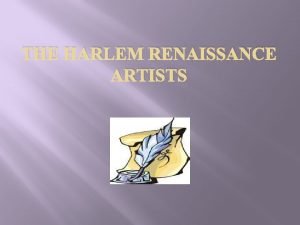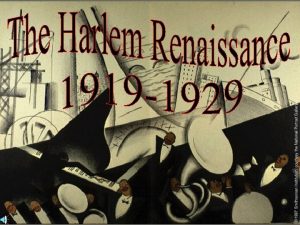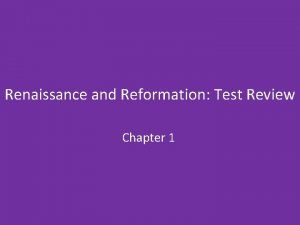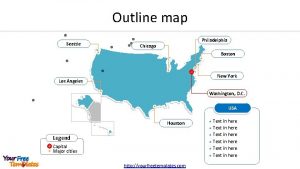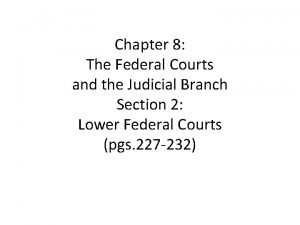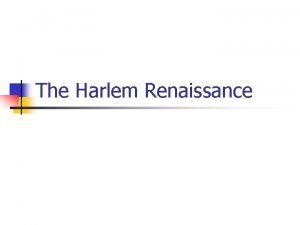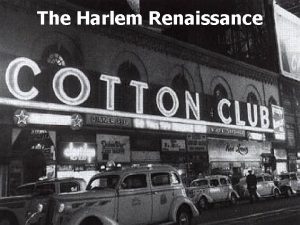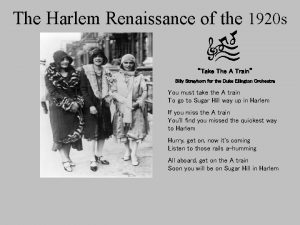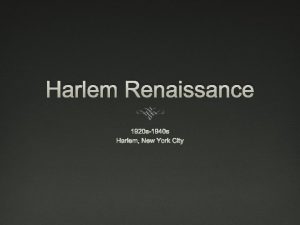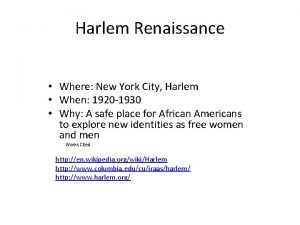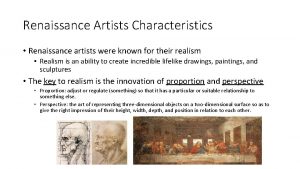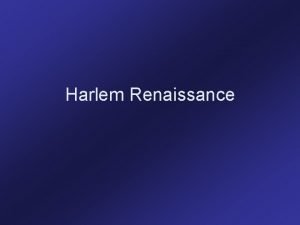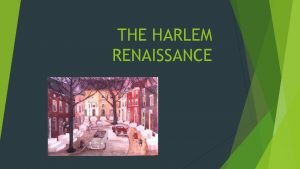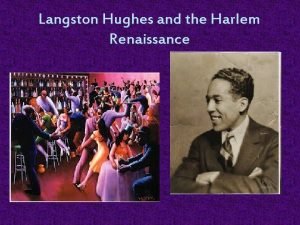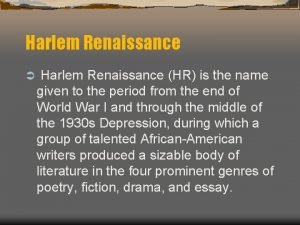THE HARLEM RENAISSANCE ARTISTS Harlem New York Map











- Slides: 11

THE HARLEM RENAISSANCE ARTISTS

Harlem, New York

Map of Harlem during the Roaring 20 s • Growing neighborhood north of Central Park with the Great Migration: better education, jobs, and racism not as severe • New York: publishing capital of Western hemisphere, major port, financial & cultural capital • Center of African American cultural awakening: intellectuals, musicians, writers, artists, business which influenced others such as Picasso

Countee Cullen 1903 – 1946 • raised by Reverend Frederick A. Cullen, pastor of one of Harlem’s largest congregations. • formal education in predominately white schools, head of newspaper & writing success early on; New York University & Harvard for master’s • informal education the streets of Harlem, • African American arts, culture • success in both black and white cultures; believed art transcended race, minimize the racial barriers

Countee Cullen’s Work Heritage What is Cullen’s message? Describe the use of “or” in this poem. What is the difference between the repeated phrase at the beginning and the end of the poem? How does the poem help you understand why the last line differs? How might Mr. Cullen’s background help influence the creation of this poem? Identify: • Imagery • Emotions • Vocabulary What is Africa to me: Copper sun or scarlet sea, Jungle star or jungle track, Strong bronzed men, or regal black Women from whose loins I sprang When the birds of Eden sang? One three centuries removed from the scenes his fathers loved, Spicy grove, cinnamon tree, What is Africa to me?

Langston Hughes 1902 -1967 • Raised by grandmother and mother, father left early to look for work • First visit to Harlem freshman year at Columbia University, graduated from Lincoln University • 19 years old published first poem • Strong commitment to social justice; early writings optimistic about social and political equality, later writings frustrated at the progress of civil rights • Used humor not violence, not regarded as role model • Carl Sandburg & Walt Whitman primary influences • Weary Blues, incorporating jazz into his poetry • The poet is not only a dreamer, but a dream keeper

Langston Hughes’ Work Words Like Freedom There are words like Freedom What is Hughes’ message? Sweet and wonderful to say. The words freedom and liberty have very similar meanings. Based on your knowledge of this time period, describe why they are used differently in this poem. On my heartstrings freedom sings How might Hughes’ background help influence the creation of this poem? Identify: • Emotions All day everyday. There are words like Liberty That almost make me cry. If you had known what I know You would know why.

Merry-Go-Round Where is the Jim Crow section On this merry-go-round, What do we learn about the poet’s past and present from this poem? What words and phrases help you to understand this? Mister, cause I want to ride? Down South where I come from White and Colored Can’t side by side. Down South on the train There’s a Jim Crow car. On the bus we’re put in the back --But there ain’t no back To a merry-go-round! Where’s the horse For a kid that’s black?

Art Knows No Racial Barriers � § Aaron Douglas 1898 -1979, study for God's Trombones, part of a four panel series, the African American journey: home, enslavement, freedom Jacob Lawrence 1917 -2000, parents part of Great Migration, mother settled in Harlem. Paintings on life of Frederic Douglass & Harriet Tubman, served in WWII.

Art Knows No Racial Barriers � Agents for Northern factories went south to recruit workers � From The Great Migration series by Jacob Lawrence

Essential Questions To A Brown Boy by Countee Cullen I, Too, Sing America and Harlem by Langston Hughes � How are these poems reflective of the authors’ point of view? � How do these poems reflect the cultural attitudes and beliefs of the time period?
 Map of harlem new york
Map of harlem new york Map of harlem nyc
Map of harlem nyc Chapter 1 renaissance and reformation
Chapter 1 renaissance and reformation New york, new jersey, pennsylvania, and delaware
New york, new jersey, pennsylvania, and delaware Marquee cinemas new hartford
Marquee cinemas new hartford Strengths of the articles of confederation
Strengths of the articles of confederation Neil thisse is a loyalist answers
Neil thisse is a loyalist answers Map boston new york
Map boston new york Federal district court map new york
Federal district court map new york Bojangles morley
Bojangles morley Bessie smith harlem renaissance
Bessie smith harlem renaissance Harlem renaissance poems
Harlem renaissance poems
